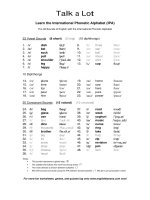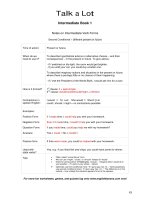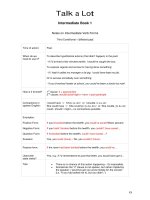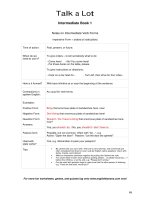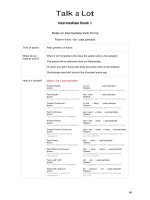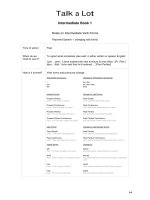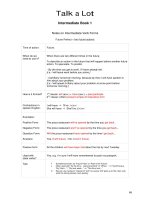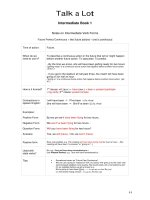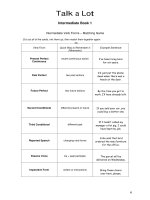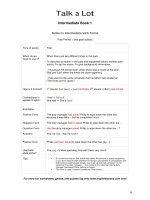talkalot intermediate book 1 present perfect continuous
Bạn đang xem bản rút gọn của tài liệu. Xem và tải ngay bản đầy đủ của tài liệu tại đây (477.95 KB, 1 trang )
Talk a Lot
Intermediate Book 1
Notes on Intermediate Verb Forms
Present Perfect Continuous = recent continuous action
Time of action:
From the past up to the recent past, or up to now (present).
When do we
need to use it?
To describe a recent continuous action, e.g. to catch up with a friend:
- What have you been doing all morning?
- I’ve been putting up wallpaper.
[It’s not clear from my words whether I’ve finished the whole job, e.g. I
might have stopped for a break.]
To describe an action that has been continuing for a period of time and
is still going on:
- How long have you been living in Bristol?
- I’ve been living here for six years.
How is it formed?
have (aux.) + been + present participle (-ing verb)
Contractions in
spoken English:
L]îKÄfåL
I have been Ö I’ve been
she has been Ö she’s been Lp]KòÄfåL
Examples:
Positive Form
Kay’s been washing dirty sheets in the hotel laundry all morning.
Negative Form
Kay hasn’t been washing dirty sheets in the hotel laundry all morning.
Question Form
Has Kay been washing dirty sheets in the hotel laundry all morning?
Answers:
Yes, she has. / No, she hasn’t.
Passive form:
Rare, but possible, e.g. The car’s been being fixed for hours!
Used with
state verbs?
No, e.g. I’ve been liking this film a lot! = I’ve liked this film a lot since…
Tips:
•
•
This form highlights the time period or duration of the action.
It is often used with a time clause to describe duration, e.g. “for
x weeks / years” or “since” + day, date, or time, as well as with
“…recently”, “..lately”, “…all day”, “this morning/afternoon”, etc.
For more fun worksheets, games, and quizzes log onto www.englishbanana.com now!
7
